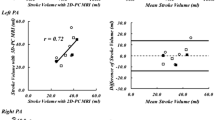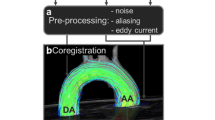Abstract
Although cine MRI-derived radiomics features in the cardiac blood pool have been used to represent cardiac function and motion, the clinical relevance of radiomics features in the great vessels is still unknown. The aim of the present study was to test the hypothesis that cine MRI-derived radiomics features of the pulmonary artery (PA) can represent hemodynamic abnormalities in pulmonary hypertension (PH). With the approval of the institutional review board (IRB), 50 PH patients (21 males, 36–89 years old, diagnosed with right heart catheterization [RHC]) and 23 healthy volunteers (14 males, 26–80 years old) were retrospectively enrolled in this study. All participants underwent cardiac 4D flow and cine MRI (25 retrospective phases) at the right ventricular (RV) outflow tract (RVOT). A total of 93 radiomics features were extracted from RVOT cine images through a fixed size region of interest (ROI) at the proximal part of the PA. The peak values of the 6 first order features were different between the PH patients and controls. 4D flow-derived mean velocity in PA was related to ‘Kurtosis’ (r = 0.452,), ‘Range’ (r = 0.426), ‘Autocorrelation’ (r = 0.407), ‘Joint Average’ (r = 0.459), ‘Sum Average’ (r = 0.459), ‘High Gray Level Emphasis’ (r = 0.41), ‘Large Dependence High Gray Level Emphasis’ (r = 0.44), ‘High Gray Level Run Emphasis’ (r = 0.422), ‘Gray Level Variance’ (r = 0.419), ‘High Gray Level Zone Emphasis’ (r = 0.451), and ‘Small Area High Gray Level Emphasis’ (r = 0.415). Mean RV pressure was related to ‘Inverse Variance’ (r = 0.43) and ‘Run Percentage’ (r = 0.403). All p values < 0.05. Cine MRI-derived PA radiomics features have the potential to serve as novel imaging biomarkers for representing hemodynamic changes in pulmonary circulation.



Similar content being viewed by others
Data Availability
The original data will be available to peers under a data sharing agreement.
References
Lin K, Sarnari R, Pathrose A et al (2021) Cine MRI detects elevated left heart pressure in pulmonary Hypertension. J Magn Reson Imaging 54:275–283
DiLorenzo MP, Bhatt SM, Mercer-Rosa L (2015) How best to assess right ventricular function by echocardiography. Cardiol Young 25:1473–1481
Fisher MR, Forfia PR, Chamera E et al (2009) Accuracy of Doppler echocardiography in the hemodynamic assessment of pulmonary Hypertension. Am J Respir Crit Care Med 179:615–621
Carlson MD, White RD, Trohman RG et al (1994) Right ventricular outflow tract ventricular tachycardia: detection of previously unrecognized anatomic abnormalities using cine magnetic resonance imaging. J Am Coll Cardiol 24:720–727
Samyn MM, Powell AJ, Garg R, Sena L, Geva T (2007) Range of ventricular dimensions and function by steady-state free precession cine MRI in repaired tetralogy of Fallot: right ventricular outflow tract patch vs. conduit repair. J Magn Reson Imaging 26:934–940
Scheffler K, Lehnhardt S (2003) Principles and applications of balanced SSFP techniques. Eur Radiol 13:2409–2418
Lin K, Sarnari R, Carr JC, Markl M (2023) Cine MRI-Derived Radiomics features of the Cardiac Blood Pool: periodicity, specificity, and reproducibility. J Magn Reson Imaging 58:807–814
Lin K, Sarnari R, Carr J, Markl M Cine MRI-derived radiomics features of the blood pool in pulmonary hypertension-heart failure with preserved ejection fraction (PH-HFpEF). 2023 ISMRM & ISMRT Annual Meeting & Exhibition 2023;Digital poster, #4867
Simonneau G, Montani D, Celermajer DS et al (2019) Haemodynamic definitions and updated clinical classification of pulmonary Hypertension. Eur Respir J ;53
Jung B, Honal M, Ullmann P, Hennig J, Markl M (2008) Highly k-t-space-accelerated phase-contrast MRI. Magn Reson Med 60:1169–1177
Vinnakota KC, Bassingthwaighte JB (2004) Myocardial density and composition: a basis for calculating intracellular metabolite concentrations. Am J Physiol Heart Circ Physiol 286:H1742–H1749
Cerne JW, Pathrose A, Gordon DZ et al (2022) Evaluation of pulmonary Hypertension using 4D Flow MRI. J Magn Reson Imaging: JMRI 56:234–245
Oechtering TH, Nowak A, Sieren MM et al (2023) Repeatability and reproducibility of various 4D Flow MRI postprocessing software programs in a multi-software and multi-vendor cross-over comparison study. J Cardiovasc Magn Reson 25:22
Voelkel NF, Quaife RA, Leinwand LA et al (2006) Right ventricular function and failure: report of a National Heart, Lung, and Blood Institute working group on cellular and molecular mechanisms of right Heart Failure. Circulation 114:1883–1891
Rao SD, Adusumalli S, Mazurek JA (2020) Pulmonary Hypertension in Heart Failure patients. Card Fail Rev 6:e05
Lin K, Sarnari R, Pathrose A et al (2021) Cine MRI characterizes HFpEF and HFrEF in post-capillary pulmonary Hypertension. Eur J Radiol 139:109679
Kamada H, Ota H, Nakamura M et al (2022) Quantification of vortex flow in pulmonary arteries of patients with chronic thromboembolic pulmonary Hypertension. Eur J Radiol 148:110142
Kroeger JR, Stackl M, Weiss K et al (2021) k-t accelerated multi-VENC 4D flow MRI improves vortex assessment in pulmonary Hypertension. Eur J Radiol 145:110035
Volandes AE, Paasche-Orlow MK, Mitchell SL et al (2013) Randomized controlled trial of a video decision support tool for cardiopulmonary resuscitation decision making in advanced cancer. J Clin Oncology: Official J Am Soc Clin Oncol 31:380–386
Saremi F, Ho SY, Cabrera JA, Sanchez-Quintana D (2013) Right ventricular outflow tract imaging with CT and MRI: part 2, function. AJR Am J Roentgenol 200:W51–61
Priya S, Aggarwal T, Ward C et al (2021) Radiomics side experiments and DAFIT approach in identifying pulmonary Hypertension using Cardiac MRI derived radiomics based machine learning models. Sci Rep 11:12686
Funding
This study was supported by grants from the National Institutes of Health (K01HL121162, R03HL144891). This study was also supported by Bayer Pharmaceutical. The grant was paid to the institution not to individual investigators.
Author information
Authors and Affiliations
Contributions
All authors contributed to the study conception and design. Material preparation, data collection and analysis were performed by KL and RS. The first draft of the manuscript was written by KL and all authors commented on previous versions of the manuscript. All authors read and approved the final manuscript.
Corresponding author
Ethics declarations
Competing interests
James C. Carr has disclosure: Siemens: research grant to institution; advisory board. Bayer: research grant to institution; advisory board; speaker. Bracco: advisory board. Guerbet: research grant to institution. Other authors have nothing to disclose.
Ethics approval
This study was performed in line with the principles of the Declaration of Helsinki. Approval was granted by the IRB of Northwestern University.
Consent to participate
Written Informed consent was obtained from all individual participants included in the study.
Consent to publish
The authors affirm that human research participants provided informed consent for publication of the deidentified images in the manuscript.
Additional information
Publisher’s Note
Springer Nature remains neutral with regard to jurisdictional claims in published maps and institutional affiliations.
Rights and permissions
Springer Nature or its licensor (e.g. a society or other partner) holds exclusive rights to this article under a publishing agreement with the author(s) or other rightsholder(s); author self-archiving of the accepted manuscript version of this article is solely governed by the terms of such publishing agreement and applicable law.
About this article
Cite this article
Lin, K., Sarnari, R., Gordon, D.Z. et al. Cine MRI-derived radiomics features indicate hemodynamic changes in the pulmonary artery. Int J Cardiovasc Imaging 40, 287–294 (2024). https://doi.org/10.1007/s10554-023-03007-5
Received:
Accepted:
Published:
Issue Date:
DOI: https://doi.org/10.1007/s10554-023-03007-5




